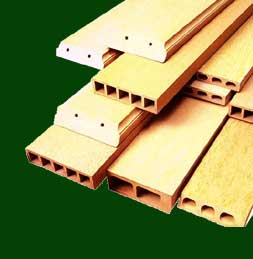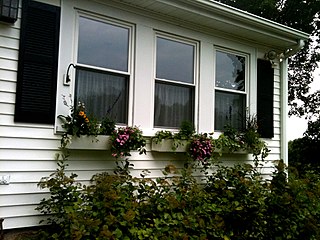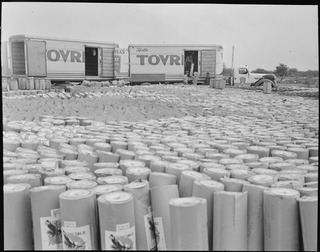 W
WAdidas Parley is a collection of clothing and footwear originated from the collaboration of German multinational company Adidas and "Parley for the Oceans", an organization that addresses environmental threats towards the oceans, through plastic pollution.
 W
WA bottle wall is a wall made out of glass or plastic bottles and binding material.
 W
WBush carpentry is an expression used in Australia and New Zealand that refers to improvised methods of building or repair, using available materials and an ad hoc design, usually in a pioneering or rural context.
 W
WCrumb rubber is recycled rubber produced from automotive and truck scrap tires. During the recycling process, steel and tire cord (fluff) are removed, leaving tire rubber with a granular consistency. Continued processing with a granulator or cracker mill, possibly with the aid of cryogenics or by mechanical means, reduces the size of the particles further. The particles are sized and classified based on various criteria including color. The granulate is sized by passing through a screen, the size based on a dimension or mesh. Crumb rubber is often used in artificial turf as cushioning.
 W
WIn the context of physical construction, deconstruction is the selective dismantlement of building components, specifically for reuse, repurposing, recycling, and waste management. It differs from demolition where a site is cleared of its building by the most expedient means. Deconstruction has also been defined as “construction in reverse”. Deconstruction requires a substantially higher degree of hands-on labor than does traditional demolition, but as such provides a viable platform for unskilled or unemployed workers to receive job skills training. The process of dismantling structures is an ancient activity that has been revived by the growing field of sustainable, green method of building.
 W
WDimension stone is natural stone or rock that has been selected and finished to specific sizes or shapes. Color, texture and pattern, and surface finish of the stone are also normal requirements. Another important selection criterion is durability: the time measure of the ability of dimension stone to endure and to maintain its essential and distinctive characteristics of strength, resistance to decay, and appearance.
 W
WA fiber-reinforced composite (FRC) is a composite building material that consists of three components:the fibers as the discontinuous or dispersed phase, the matrix as the continuous phase, and the fine interphase region, also known as the interface.
 W
WA natural building involves a range of building systems and materials that place major emphasis on sustainability. Ways of achieving sustainability through natural building focus on durability and the use of minimally processed, plentiful or renewable resources, as well as those that, while recycled or salvaged, produce healthy living environments and maintain indoor air quality. Natural building tends to rely on human labor, more than technology. As Michael G. Smith observes, it depends on "local ecology, geology and climate; on the character of the particular building site, and on the needs and personalities of the builders and users."
 W
WPapercrete is a building material that consists of re-pulped paper fiber with Portland cement or clay and/or other soil added. First patented in 1928, it was revived during the 1980s. Although perceived as an environmentally friendly material due to the significant recycled content, this is offset by the presence of cement. The material lacks standardisation, and proper use therefore requires care and experience. Eric Patterson and Mike McCain, who have been credited with independently "inventing" papercrete, have both contributed considerably to research into machinery to make it and ways of using it for building.
 W
WPhonehenge West was a large folk art structure envisioned and constructed by Alan Kimble "Kim" Fahey, which included a 70 foot tower made from reclaimed material and props from old movie sets. The structure rested on his 1.7 acre property in Acton, California. The compound included 13 structures and was a representation of folk art.
 W
WPlastic lumber (PL) is a plastic form of lumber (timber) made of virgin or recycled plastic. It is made of 100% plastic, compared with wood-plastic composite lumber.
 W
WPykrete is a frozen ice alloy, originally made of approximately 14 percent sawdust or some other form of wood pulp and 86 percent ice by weight. During World War II, Geoffrey Pyke proposed it as a candidate material for a supersized aircraft carrier for the British Royal Navy. Pykrete features unusual properties, including a relatively slow melting rate due to its low thermal conductivity, as well as a vastly improved strength and toughness compared to ordinary ice. These physical properties can make the material comparable to concrete, as long as the material is kept frozen.
 W
WReclaimed lumber is processed wood retrieved from its original application for purposes of subsequent use. Most reclaimed lumber comes from timbers and decking rescued from old barns, factories and warehouses, although some companies use wood from less traditional structures such as boxcars, coal mines and wine barrels. Reclaimed or antique lumber is used primarily for decoration and home building, for example for siding, architectural details, cabinetry, furniture and flooring.
 W
WRed rosin paper is a 100% recycled heavy duty felt paper used in construction such as underlayment under flooring and siding. The name "rosin-sized sheathing paper", commonly used to describe the material, comes from the rosin used in the paper, the process of sizing it to add the rosin, and its use by builders. "Alum-rosin size was invented by Moritz Friedrich Illig in Germany in 1807..." and is known to have been used as a building paper by 1850.
 W
WStraw-bale construction is a building method that uses bales of straw as structural elements, building insulation, or both. This construction method is commonly used in natural building or "brown" construction projects. Research has shown that straw-bale construction is a sustainable method for building, from the standpoint of both materials and energy needed for heating and cooling.
 W
WTimber recycling or wood recycling is the process of turning waste timber into usable products. Recycling timber is a practice that was popularized in the early 1990s as issues such as deforestation and climate change prompted both timber suppliers and consumers to turn to a more sustainable timber source. Recycling timber is the environmentally friendliest form of timber production and is very common in countries such as Australia and New Zealand where supplies of old wooden structures are plentiful. Timber can be chipped down into wood chips which can be used to power homes or power plants.
 W
WTrex Company, Inc. is a major manufacturer of wood-alternative composite decking, railing, and other outdoor items made from recycled materials. Headquartered in Winchester, Virginia, Trex is world’s largest manufacturer of wood-alternative decking and railing. Trex composite products are made of 95% recycled materials. In redirecting more than 400 million pounds of plastic and scrap wood from landfills each year, Trex is one of the largest plastic film recyclers in the US.
 W
WTunnel rock recycling is a method to process rock debris from tunneling into other usable needs. The most common is for concrete aggregates or as subbase for road building. Crushers and screeners normally used in quarries are stationed at the tunnel site for the purpose which is to crush and screen the rock debris for further use. The largest tunnel rock recycling facility ever to be created was for the construction of the Gotthard Base Tunnel which took 17 years, finishing in 2016. 1/5 of the rock debris excavated for the tunnel was recycled and used as aggregates for the concrete lining inside the tunnel.
 W
WWood-plastic composites (WPCs) are composite materials made of wood fiber/wood flour and thermoplastic(s) such as PE, PP, PVC, or PLA.